Business Strategy of Manchester United: Stakeholders and Culture
VerifiedAdded on 2020/10/05
|11
|3267
|117
Report
AI Summary
This report provides a detailed analysis of Manchester United Football Club's (MUFC) business strategy. It begins by identifying key stakeholders, such as the Glazer Family, sponsors, fans, and media, and evaluates their power and interest using the Stakeholder Mapping model, highlighting potential conflicts in expectations. The report then critically examines the cultural characteristics of MUFC, comparing its evolution from a PLC in 1991 to the present day, referencing Handy's Culture theory to explain the changes in values, beliefs, and assumptions. The analysis covers the shift from a focus on tradition and community to a more profit-driven approach. Finally, the report discusses the implications of these cultural changes for MUFC's current and future strategies, including the impact on financial decisions, player management, and the club's global brand. The report concludes by summarizing the key findings and implications for the club's long-term success.
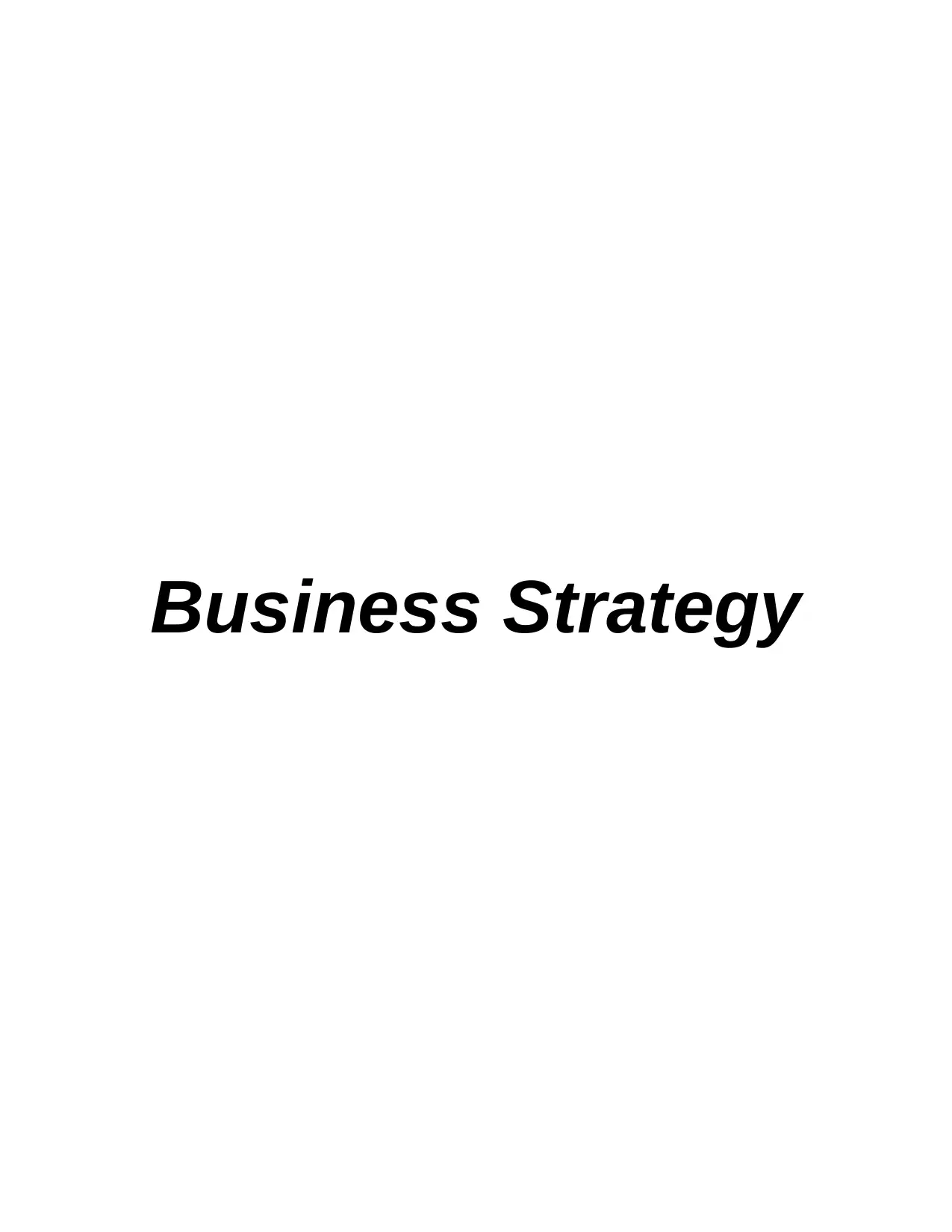
Business Strategy
Paraphrase This Document
Need a fresh take? Get an instant paraphrase of this document with our AI Paraphraser
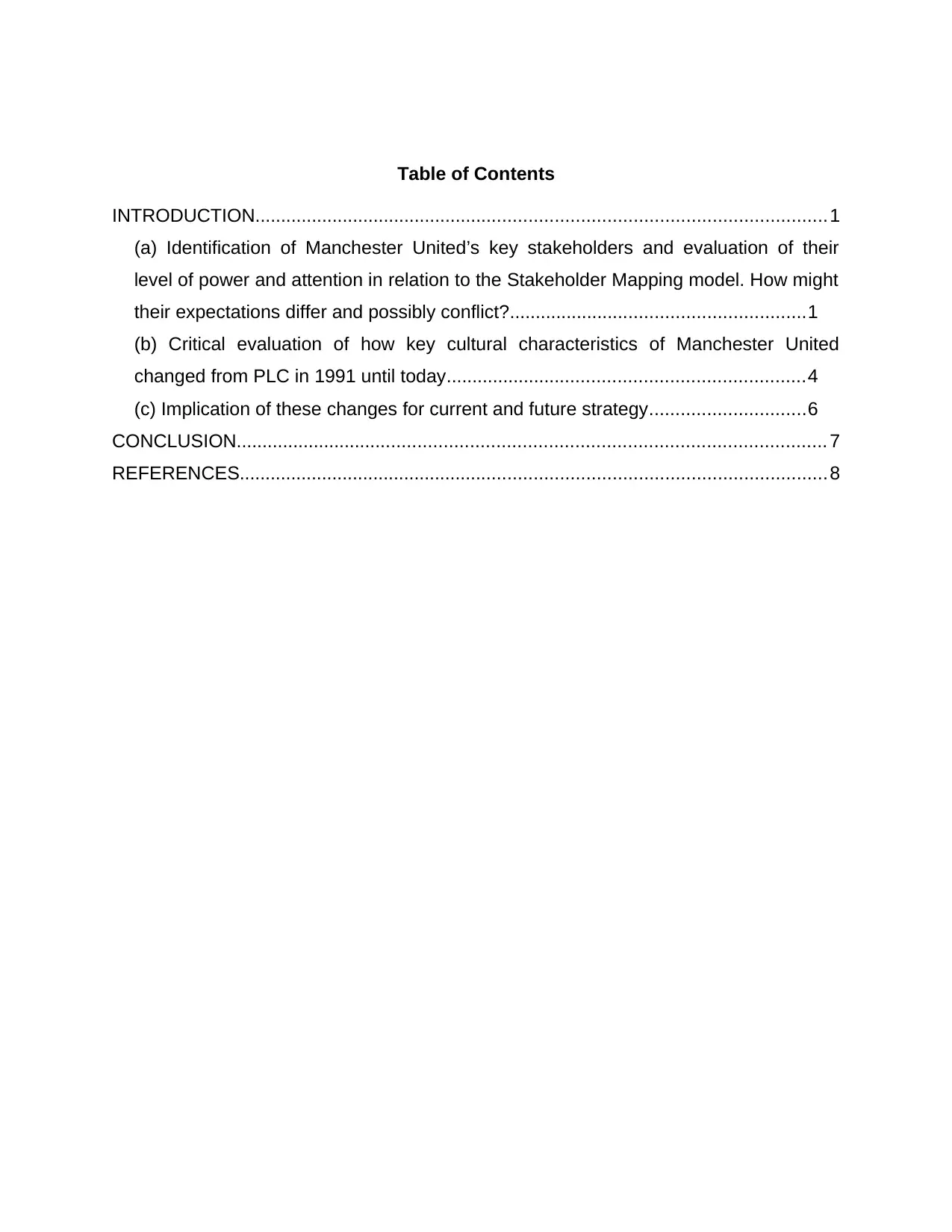
Table of Contents
INTRODUCTION..............................................................................................................1
(a) Identification of Manchester United’s key stakeholders and evaluation of their
level of power and attention in relation to the Stakeholder Mapping model. How might
their expectations differ and possibly conflict?.........................................................1
(b) Critical evaluation of how key cultural characteristics of Manchester United
changed from PLC in 1991 until today.....................................................................4
(c) Implication of these changes for current and future strategy..............................6
CONCLUSION................................................................................................................. 7
REFERENCES.................................................................................................................8
INTRODUCTION..............................................................................................................1
(a) Identification of Manchester United’s key stakeholders and evaluation of their
level of power and attention in relation to the Stakeholder Mapping model. How might
their expectations differ and possibly conflict?.........................................................1
(b) Critical evaluation of how key cultural characteristics of Manchester United
changed from PLC in 1991 until today.....................................................................4
(c) Implication of these changes for current and future strategy..............................6
CONCLUSION................................................................................................................. 7
REFERENCES.................................................................................................................8
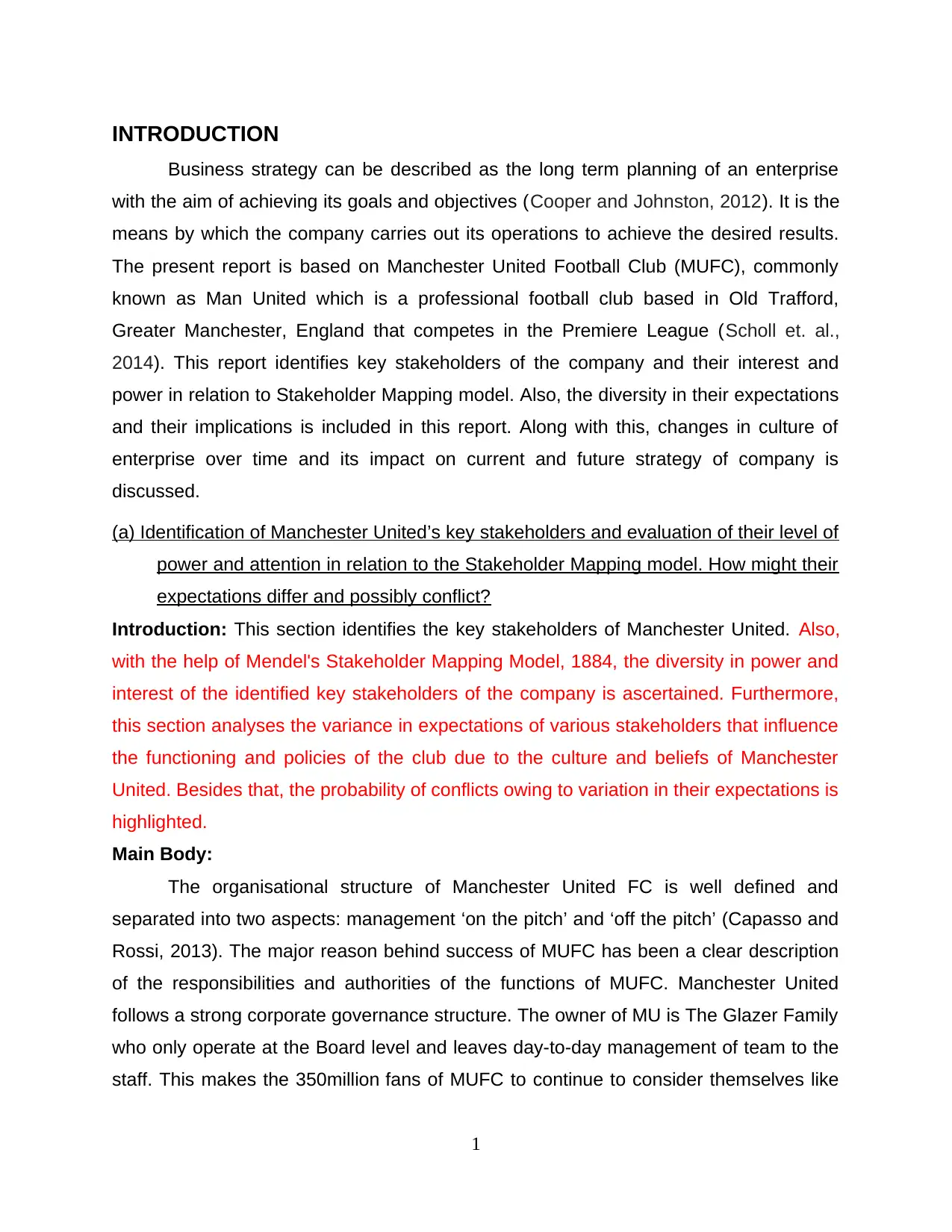
INTRODUCTION
Business strategy can be described as the long term planning of an enterprise
with the aim of achieving its goals and objectives (Cooper and Johnston, 2012). It is the
means by which the company carries out its operations to achieve the desired results.
The present report is based on Manchester United Football Club (MUFC), commonly
known as Man United which is a professional football club based in Old Trafford,
Greater Manchester, England that competes in the Premiere League (Scholl et. al.,
2014). This report identifies key stakeholders of the company and their interest and
power in relation to Stakeholder Mapping model. Also, the diversity in their expectations
and their implications is included in this report. Along with this, changes in culture of
enterprise over time and its impact on current and future strategy of company is
discussed.
(a) Identification of Manchester United’s key stakeholders and evaluation of their level of
power and attention in relation to the Stakeholder Mapping model. How might their
expectations differ and possibly conflict?
Introduction: This section identifies the key stakeholders of Manchester United. Also,
with the help of Mendel's Stakeholder Mapping Model, 1884, the diversity in power and
interest of the identified key stakeholders of the company is ascertained. Furthermore,
this section analyses the variance in expectations of various stakeholders that influence
the functioning and policies of the club due to the culture and beliefs of Manchester
United. Besides that, the probability of conflicts owing to variation in their expectations is
highlighted.
Main Body:
The organisational structure of Manchester United FC is well defined and
separated into two aspects: management ‘on the pitch’ and ‘off the pitch’ (Capasso and
Rossi, 2013). The major reason behind success of MUFC has been a clear description
of the responsibilities and authorities of the functions of MUFC. Manchester United
follows a strong corporate governance structure. The owner of MU is The Glazer Family
who only operate at the Board level and leaves day-to-day management of team to the
staff. This makes the 350million fans of MUFC to continue to consider themselves like
1
Business strategy can be described as the long term planning of an enterprise
with the aim of achieving its goals and objectives (Cooper and Johnston, 2012). It is the
means by which the company carries out its operations to achieve the desired results.
The present report is based on Manchester United Football Club (MUFC), commonly
known as Man United which is a professional football club based in Old Trafford,
Greater Manchester, England that competes in the Premiere League (Scholl et. al.,
2014). This report identifies key stakeholders of the company and their interest and
power in relation to Stakeholder Mapping model. Also, the diversity in their expectations
and their implications is included in this report. Along with this, changes in culture of
enterprise over time and its impact on current and future strategy of company is
discussed.
(a) Identification of Manchester United’s key stakeholders and evaluation of their level of
power and attention in relation to the Stakeholder Mapping model. How might their
expectations differ and possibly conflict?
Introduction: This section identifies the key stakeholders of Manchester United. Also,
with the help of Mendel's Stakeholder Mapping Model, 1884, the diversity in power and
interest of the identified key stakeholders of the company is ascertained. Furthermore,
this section analyses the variance in expectations of various stakeholders that influence
the functioning and policies of the club due to the culture and beliefs of Manchester
United. Besides that, the probability of conflicts owing to variation in their expectations is
highlighted.
Main Body:
The organisational structure of Manchester United FC is well defined and
separated into two aspects: management ‘on the pitch’ and ‘off the pitch’ (Capasso and
Rossi, 2013). The major reason behind success of MUFC has been a clear description
of the responsibilities and authorities of the functions of MUFC. Manchester United
follows a strong corporate governance structure. The owner of MU is The Glazer Family
who only operate at the Board level and leaves day-to-day management of team to the
staff. This makes the 350million fans of MUFC to continue to consider themselves like
1
⊘ This is a preview!⊘
Do you want full access?
Subscribe today to unlock all pages.

Trusted by 1+ million students worldwide
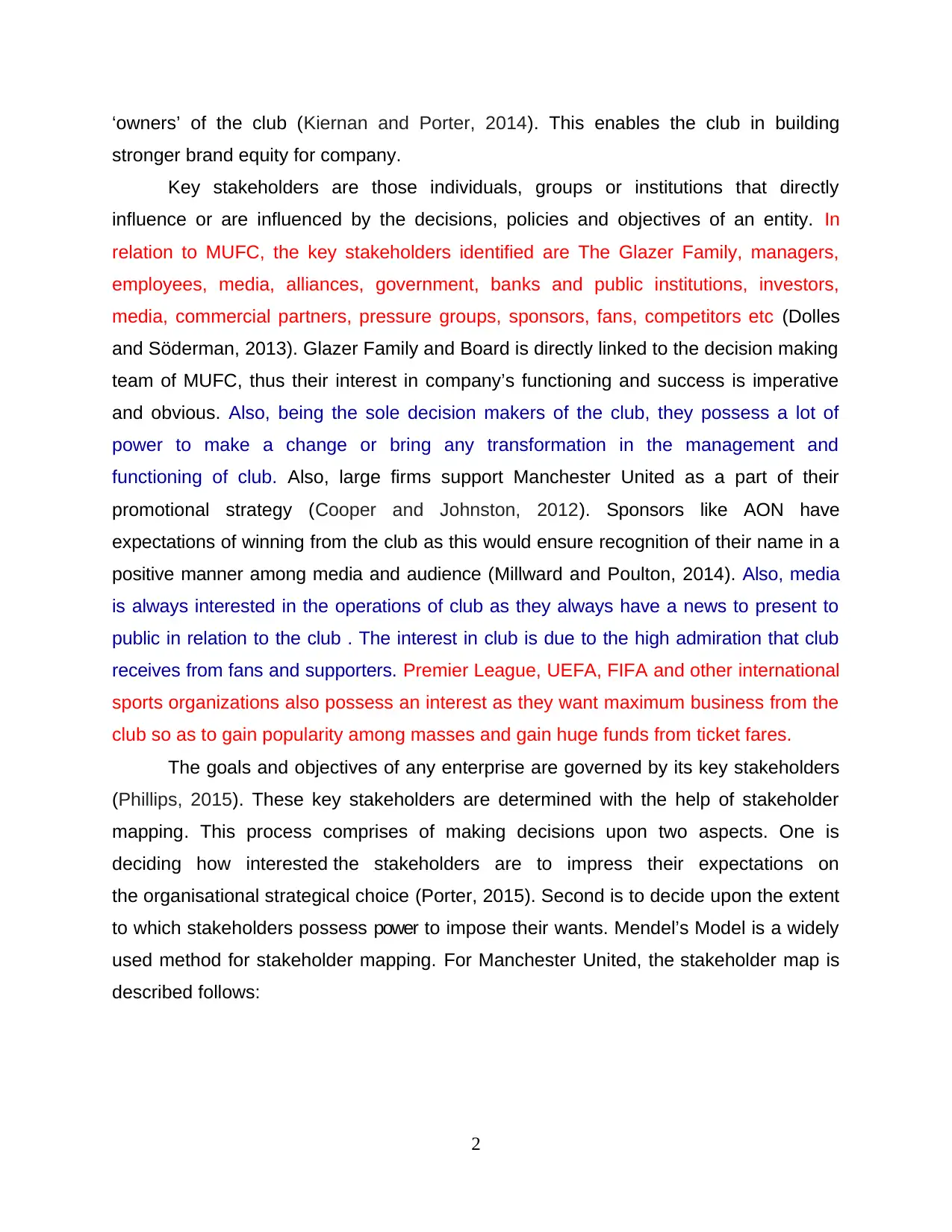
‘owners’ of the club (Kiernan and Porter, 2014). This enables the club in building
stronger brand equity for company.
Key stakeholders are those individuals, groups or institutions that directly
influence or are influenced by the decisions, policies and objectives of an entity. In
relation to MUFC, the key stakeholders identified are The Glazer Family, managers,
employees, media, alliances, government, banks and public institutions, investors,
media, commercial partners, pressure groups, sponsors, fans, competitors etc (Dolles
and Söderman, 2013). Glazer Family and Board is directly linked to the decision making
team of MUFC, thus their interest in company’s functioning and success is imperative
and obvious. Also, being the sole decision makers of the club, they possess a lot of
power to make a change or bring any transformation in the management and
functioning of club. Also, large firms support Manchester United as a part of their
promotional strategy (Cooper and Johnston, 2012). Sponsors like AON have
expectations of winning from the club as this would ensure recognition of their name in a
positive manner among media and audience (Millward and Poulton, 2014). Also, media
is always interested in the operations of club as they always have a news to present to
public in relation to the club . The interest in club is due to the high admiration that club
receives from fans and supporters. Premier League, UEFA, FIFA and other international
sports organizations also possess an interest as they want maximum business from the
club so as to gain popularity among masses and gain huge funds from ticket fares.
The goals and objectives of any enterprise are governed by its key stakeholders
(Phillips, 2015). These key stakeholders are determined with the help of stakeholder
mapping. This process comprises of making decisions upon two aspects. One is
deciding how interested the stakeholders are to impress their expectations on
the organisational strategical choice (Porter, 2015). Second is to decide upon the extent
to which stakeholders possess power to impose their wants. Mendel’s Model is a widely
used method for stakeholder mapping. For Manchester United, the stakeholder map is
described follows:
2
stronger brand equity for company.
Key stakeholders are those individuals, groups or institutions that directly
influence or are influenced by the decisions, policies and objectives of an entity. In
relation to MUFC, the key stakeholders identified are The Glazer Family, managers,
employees, media, alliances, government, banks and public institutions, investors,
media, commercial partners, pressure groups, sponsors, fans, competitors etc (Dolles
and Söderman, 2013). Glazer Family and Board is directly linked to the decision making
team of MUFC, thus their interest in company’s functioning and success is imperative
and obvious. Also, being the sole decision makers of the club, they possess a lot of
power to make a change or bring any transformation in the management and
functioning of club. Also, large firms support Manchester United as a part of their
promotional strategy (Cooper and Johnston, 2012). Sponsors like AON have
expectations of winning from the club as this would ensure recognition of their name in a
positive manner among media and audience (Millward and Poulton, 2014). Also, media
is always interested in the operations of club as they always have a news to present to
public in relation to the club . The interest in club is due to the high admiration that club
receives from fans and supporters. Premier League, UEFA, FIFA and other international
sports organizations also possess an interest as they want maximum business from the
club so as to gain popularity among masses and gain huge funds from ticket fares.
The goals and objectives of any enterprise are governed by its key stakeholders
(Phillips, 2015). These key stakeholders are determined with the help of stakeholder
mapping. This process comprises of making decisions upon two aspects. One is
deciding how interested the stakeholders are to impress their expectations on
the organisational strategical choice (Porter, 2015). Second is to decide upon the extent
to which stakeholders possess power to impose their wants. Mendel’s Model is a widely
used method for stakeholder mapping. For Manchester United, the stakeholder map is
described follows:
2
Paraphrase This Document
Need a fresh take? Get an instant paraphrase of this document with our AI Paraphraser
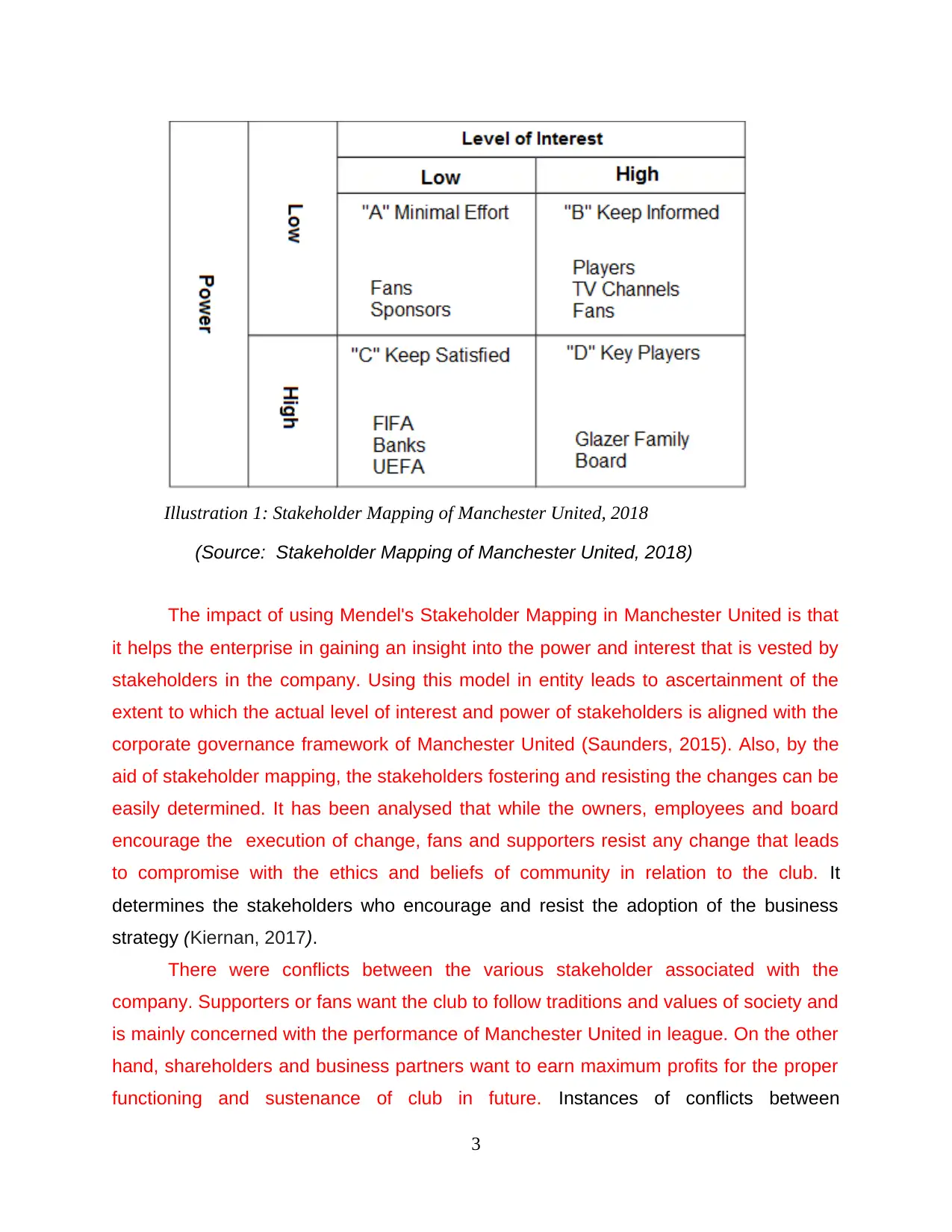
Illustration 1: Stakeholder Mapping of Manchester United, 2018
(Source: Stakeholder Mapping of Manchester United, 2018)
The impact of using Mendel's Stakeholder Mapping in Manchester United is that
it helps the enterprise in gaining an insight into the power and interest that is vested by
stakeholders in the company. Using this model in entity leads to ascertainment of the
extent to which the actual level of interest and power of stakeholders is aligned with the
corporate governance framework of Manchester United (Saunders, 2015). Also, by the
aid of stakeholder mapping, the stakeholders fostering and resisting the changes can be
easily determined. It has been analysed that while the owners, employees and board
encourage the execution of change, fans and supporters resist any change that leads
to compromise with the ethics and beliefs of community in relation to the club. It
determines the stakeholders who encourage and resist the adoption of the business
strategy (Kiernan, 2017).
There were conflicts between the various stakeholder associated with the
company. Supporters or fans want the club to follow traditions and values of society and
is mainly concerned with the performance of Manchester United in league. On the other
hand, shareholders and business partners want to earn maximum profits for the proper
functioning and sustenance of club in future. Instances of conflicts between
3
(Source: Stakeholder Mapping of Manchester United, 2018)
The impact of using Mendel's Stakeholder Mapping in Manchester United is that
it helps the enterprise in gaining an insight into the power and interest that is vested by
stakeholders in the company. Using this model in entity leads to ascertainment of the
extent to which the actual level of interest and power of stakeholders is aligned with the
corporate governance framework of Manchester United (Saunders, 2015). Also, by the
aid of stakeholder mapping, the stakeholders fostering and resisting the changes can be
easily determined. It has been analysed that while the owners, employees and board
encourage the execution of change, fans and supporters resist any change that leads
to compromise with the ethics and beliefs of community in relation to the club. It
determines the stakeholders who encourage and resist the adoption of the business
strategy (Kiernan, 2017).
There were conflicts between the various stakeholder associated with the
company. Supporters or fans want the club to follow traditions and values of society and
is mainly concerned with the performance of Manchester United in league. On the other
hand, shareholders and business partners want to earn maximum profits for the proper
functioning and sustenance of club in future. Instances of conflicts between
3
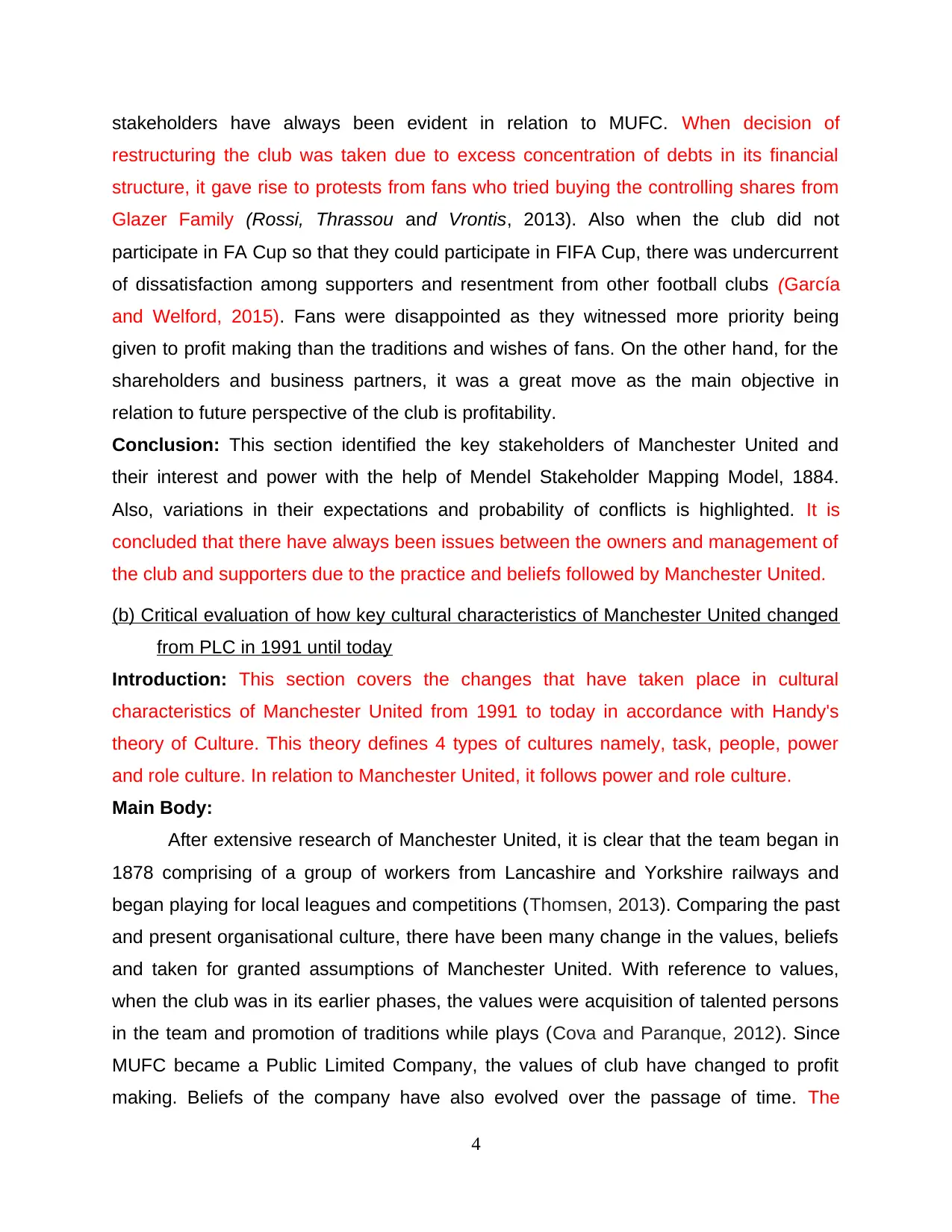
stakeholders have always been evident in relation to MUFC. When decision of
restructuring the club was taken due to excess concentration of debts in its financial
structure, it gave rise to protests from fans who tried buying the controlling shares from
Glazer Family (Rossi, Thrassou and Vrontis, 2013). Also when the club did not
participate in FA Cup so that they could participate in FIFA Cup, there was undercurrent
of dissatisfaction among supporters and resentment from other football clubs (García
and Welford, 2015). Fans were disappointed as they witnessed more priority being
given to profit making than the traditions and wishes of fans. On the other hand, for the
shareholders and business partners, it was a great move as the main objective in
relation to future perspective of the club is profitability.
Conclusion: This section identified the key stakeholders of Manchester United and
their interest and power with the help of Mendel Stakeholder Mapping Model, 1884.
Also, variations in their expectations and probability of conflicts is highlighted. It is
concluded that there have always been issues between the owners and management of
the club and supporters due to the practice and beliefs followed by Manchester United.
(b) Critical evaluation of how key cultural characteristics of Manchester United changed
from PLC in 1991 until today
Introduction: This section covers the changes that have taken place in cultural
characteristics of Manchester United from 1991 to today in accordance with Handy's
theory of Culture. This theory defines 4 types of cultures namely, task, people, power
and role culture. In relation to Manchester United, it follows power and role culture.
Main Body:
After extensive research of Manchester United, it is clear that the team began in
1878 comprising of a group of workers from Lancashire and Yorkshire railways and
began playing for local leagues and competitions (Thomsen, 2013). Comparing the past
and present organisational culture, there have been many change in the values, beliefs
and taken for granted assumptions of Manchester United. With reference to values,
when the club was in its earlier phases, the values were acquisition of talented persons
in the team and promotion of traditions while plays (Cova and Paranque, 2012). Since
MUFC became a Public Limited Company, the values of club have changed to profit
making. Beliefs of the company have also evolved over the passage of time. The
4
restructuring the club was taken due to excess concentration of debts in its financial
structure, it gave rise to protests from fans who tried buying the controlling shares from
Glazer Family (Rossi, Thrassou and Vrontis, 2013). Also when the club did not
participate in FA Cup so that they could participate in FIFA Cup, there was undercurrent
of dissatisfaction among supporters and resentment from other football clubs (García
and Welford, 2015). Fans were disappointed as they witnessed more priority being
given to profit making than the traditions and wishes of fans. On the other hand, for the
shareholders and business partners, it was a great move as the main objective in
relation to future perspective of the club is profitability.
Conclusion: This section identified the key stakeholders of Manchester United and
their interest and power with the help of Mendel Stakeholder Mapping Model, 1884.
Also, variations in their expectations and probability of conflicts is highlighted. It is
concluded that there have always been issues between the owners and management of
the club and supporters due to the practice and beliefs followed by Manchester United.
(b) Critical evaluation of how key cultural characteristics of Manchester United changed
from PLC in 1991 until today
Introduction: This section covers the changes that have taken place in cultural
characteristics of Manchester United from 1991 to today in accordance with Handy's
theory of Culture. This theory defines 4 types of cultures namely, task, people, power
and role culture. In relation to Manchester United, it follows power and role culture.
Main Body:
After extensive research of Manchester United, it is clear that the team began in
1878 comprising of a group of workers from Lancashire and Yorkshire railways and
began playing for local leagues and competitions (Thomsen, 2013). Comparing the past
and present organisational culture, there have been many change in the values, beliefs
and taken for granted assumptions of Manchester United. With reference to values,
when the club was in its earlier phases, the values were acquisition of talented persons
in the team and promotion of traditions while plays (Cova and Paranque, 2012). Since
MUFC became a Public Limited Company, the values of club have changed to profit
making. Beliefs of the company have also evolved over the passage of time. The
4
⊘ This is a preview!⊘
Do you want full access?
Subscribe today to unlock all pages.

Trusted by 1+ million students worldwide
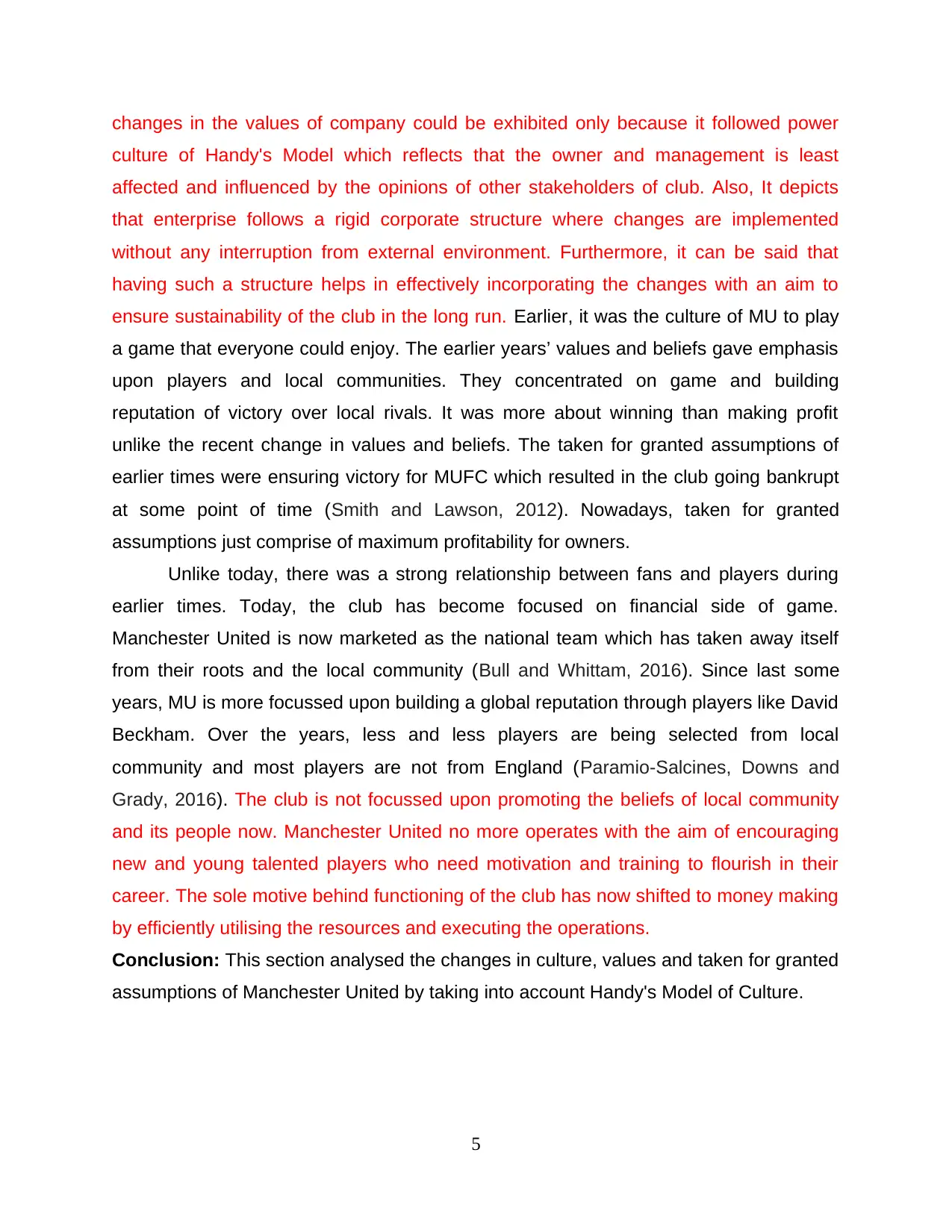
changes in the values of company could be exhibited only because it followed power
culture of Handy's Model which reflects that the owner and management is least
affected and influenced by the opinions of other stakeholders of club. Also, It depicts
that enterprise follows a rigid corporate structure where changes are implemented
without any interruption from external environment. Furthermore, it can be said that
having such a structure helps in effectively incorporating the changes with an aim to
ensure sustainability of the club in the long run. Earlier, it was the culture of MU to play
a game that everyone could enjoy. The earlier years’ values and beliefs gave emphasis
upon players and local communities. They concentrated on game and building
reputation of victory over local rivals. It was more about winning than making profit
unlike the recent change in values and beliefs. The taken for granted assumptions of
earlier times were ensuring victory for MUFC which resulted in the club going bankrupt
at some point of time (Smith and Lawson, 2012). Nowadays, taken for granted
assumptions just comprise of maximum profitability for owners.
Unlike today, there was a strong relationship between fans and players during
earlier times. Today, the club has become focused on financial side of game.
Manchester United is now marketed as the national team which has taken away itself
from their roots and the local community (Bull and Whittam, 2016). Since last some
years, MU is more focussed upon building a global reputation through players like David
Beckham. Over the years, less and less players are being selected from local
community and most players are not from England (Paramio-Salcines, Downs and
Grady, 2016). The club is not focussed upon promoting the beliefs of local community
and its people now. Manchester United no more operates with the aim of encouraging
new and young talented players who need motivation and training to flourish in their
career. The sole motive behind functioning of the club has now shifted to money making
by efficiently utilising the resources and executing the operations.
Conclusion: This section analysed the changes in culture, values and taken for granted
assumptions of Manchester United by taking into account Handy's Model of Culture.
5
culture of Handy's Model which reflects that the owner and management is least
affected and influenced by the opinions of other stakeholders of club. Also, It depicts
that enterprise follows a rigid corporate structure where changes are implemented
without any interruption from external environment. Furthermore, it can be said that
having such a structure helps in effectively incorporating the changes with an aim to
ensure sustainability of the club in the long run. Earlier, it was the culture of MU to play
a game that everyone could enjoy. The earlier years’ values and beliefs gave emphasis
upon players and local communities. They concentrated on game and building
reputation of victory over local rivals. It was more about winning than making profit
unlike the recent change in values and beliefs. The taken for granted assumptions of
earlier times were ensuring victory for MUFC which resulted in the club going bankrupt
at some point of time (Smith and Lawson, 2012). Nowadays, taken for granted
assumptions just comprise of maximum profitability for owners.
Unlike today, there was a strong relationship between fans and players during
earlier times. Today, the club has become focused on financial side of game.
Manchester United is now marketed as the national team which has taken away itself
from their roots and the local community (Bull and Whittam, 2016). Since last some
years, MU is more focussed upon building a global reputation through players like David
Beckham. Over the years, less and less players are being selected from local
community and most players are not from England (Paramio-Salcines, Downs and
Grady, 2016). The club is not focussed upon promoting the beliefs of local community
and its people now. Manchester United no more operates with the aim of encouraging
new and young talented players who need motivation and training to flourish in their
career. The sole motive behind functioning of the club has now shifted to money making
by efficiently utilising the resources and executing the operations.
Conclusion: This section analysed the changes in culture, values and taken for granted
assumptions of Manchester United by taking into account Handy's Model of Culture.
5
Paraphrase This Document
Need a fresh take? Get an instant paraphrase of this document with our AI Paraphraser
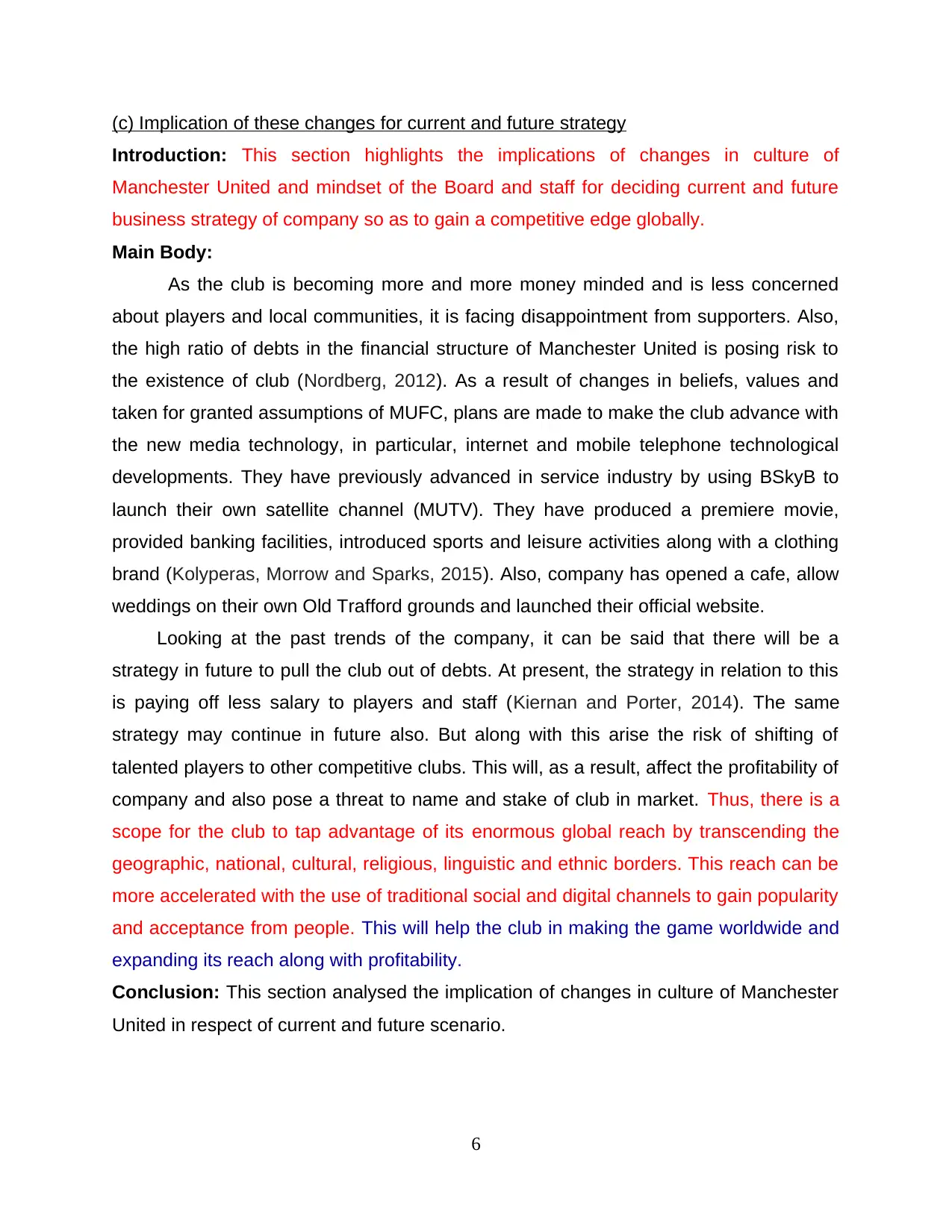
(c) Implication of these changes for current and future strategy
Introduction: This section highlights the implications of changes in culture of
Manchester United and mindset of the Board and staff for deciding current and future
business strategy of company so as to gain a competitive edge globally.
Main Body:
As the club is becoming more and more money minded and is less concerned
about players and local communities, it is facing disappointment from supporters. Also,
the high ratio of debts in the financial structure of Manchester United is posing risk to
the existence of club (Nordberg, 2012). As a result of changes in beliefs, values and
taken for granted assumptions of MUFC, plans are made to make the club advance with
the new media technology, in particular, internet and mobile telephone technological
developments. They have previously advanced in service industry by using BSkyB to
launch their own satellite channel (MUTV). They have produced a premiere movie,
provided banking facilities, introduced sports and leisure activities along with a clothing
brand (Kolyperas, Morrow and Sparks, 2015). Also, company has opened a cafe, allow
weddings on their own Old Trafford grounds and launched their official website.
Looking at the past trends of the company, it can be said that there will be a
strategy in future to pull the club out of debts. At present, the strategy in relation to this
is paying off less salary to players and staff (Kiernan and Porter, 2014). The same
strategy may continue in future also. But along with this arise the risk of shifting of
talented players to other competitive clubs. This will, as a result, affect the profitability of
company and also pose a threat to name and stake of club in market. Thus, there is a
scope for the club to tap advantage of its enormous global reach by transcending the
geographic, national, cultural, religious, linguistic and ethnic borders. This reach can be
more accelerated with the use of traditional social and digital channels to gain popularity
and acceptance from people. This will help the club in making the game worldwide and
expanding its reach along with profitability.
Conclusion: This section analysed the implication of changes in culture of Manchester
United in respect of current and future scenario.
6
Introduction: This section highlights the implications of changes in culture of
Manchester United and mindset of the Board and staff for deciding current and future
business strategy of company so as to gain a competitive edge globally.
Main Body:
As the club is becoming more and more money minded and is less concerned
about players and local communities, it is facing disappointment from supporters. Also,
the high ratio of debts in the financial structure of Manchester United is posing risk to
the existence of club (Nordberg, 2012). As a result of changes in beliefs, values and
taken for granted assumptions of MUFC, plans are made to make the club advance with
the new media technology, in particular, internet and mobile telephone technological
developments. They have previously advanced in service industry by using BSkyB to
launch their own satellite channel (MUTV). They have produced a premiere movie,
provided banking facilities, introduced sports and leisure activities along with a clothing
brand (Kolyperas, Morrow and Sparks, 2015). Also, company has opened a cafe, allow
weddings on their own Old Trafford grounds and launched their official website.
Looking at the past trends of the company, it can be said that there will be a
strategy in future to pull the club out of debts. At present, the strategy in relation to this
is paying off less salary to players and staff (Kiernan and Porter, 2014). The same
strategy may continue in future also. But along with this arise the risk of shifting of
talented players to other competitive clubs. This will, as a result, affect the profitability of
company and also pose a threat to name and stake of club in market. Thus, there is a
scope for the club to tap advantage of its enormous global reach by transcending the
geographic, national, cultural, religious, linguistic and ethnic borders. This reach can be
more accelerated with the use of traditional social and digital channels to gain popularity
and acceptance from people. This will help the club in making the game worldwide and
expanding its reach along with profitability.
Conclusion: This section analysed the implication of changes in culture of Manchester
United in respect of current and future scenario.
6
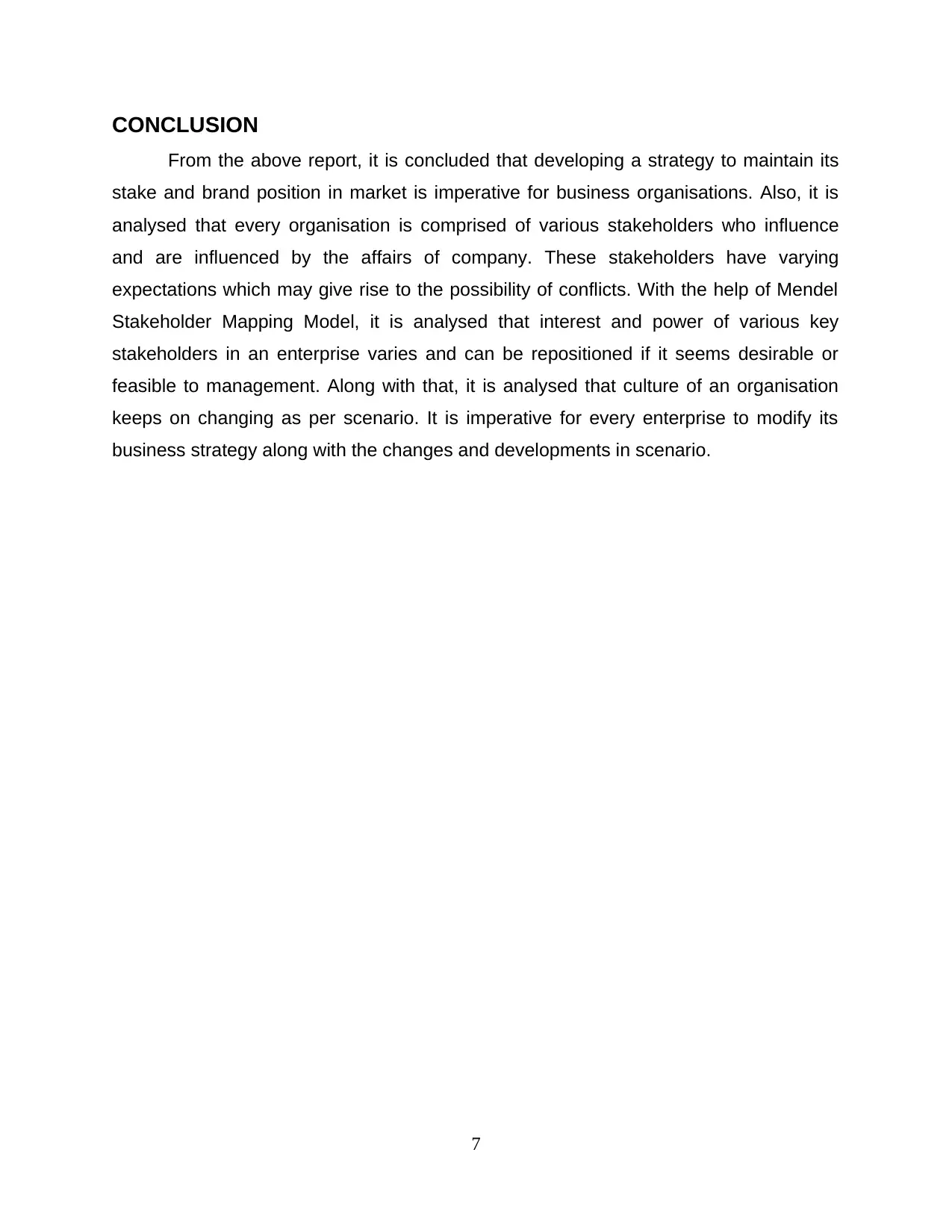
CONCLUSION
From the above report, it is concluded that developing a strategy to maintain its
stake and brand position in market is imperative for business organisations. Also, it is
analysed that every organisation is comprised of various stakeholders who influence
and are influenced by the affairs of company. These stakeholders have varying
expectations which may give rise to the possibility of conflicts. With the help of Mendel
Stakeholder Mapping Model, it is analysed that interest and power of various key
stakeholders in an enterprise varies and can be repositioned if it seems desirable or
feasible to management. Along with that, it is analysed that culture of an organisation
keeps on changing as per scenario. It is imperative for every enterprise to modify its
business strategy along with the changes and developments in scenario.
7
From the above report, it is concluded that developing a strategy to maintain its
stake and brand position in market is imperative for business organisations. Also, it is
analysed that every organisation is comprised of various stakeholders who influence
and are influenced by the affairs of company. These stakeholders have varying
expectations which may give rise to the possibility of conflicts. With the help of Mendel
Stakeholder Mapping Model, it is analysed that interest and power of various key
stakeholders in an enterprise varies and can be repositioned if it seems desirable or
feasible to management. Along with that, it is analysed that culture of an organisation
keeps on changing as per scenario. It is imperative for every enterprise to modify its
business strategy along with the changes and developments in scenario.
7
⊘ This is a preview!⊘
Do you want full access?
Subscribe today to unlock all pages.

Trusted by 1+ million students worldwide
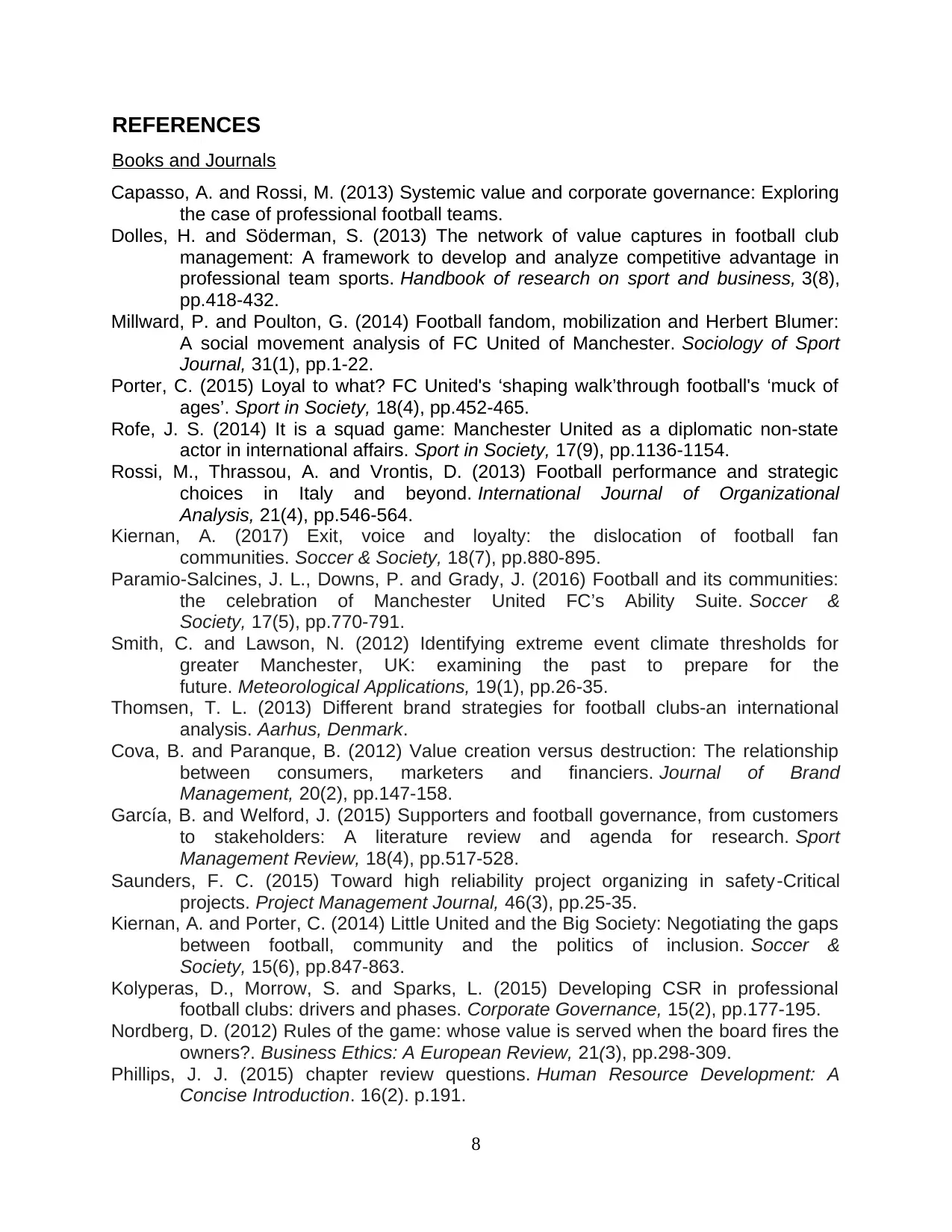
REFERENCES
Books and Journals
Capasso, A. and Rossi, M. (2013) Systemic value and corporate governance: Exploring
the case of professional football teams.
Dolles, H. and Söderman, S. (2013) The network of value captures in football club
management: A framework to develop and analyze competitive advantage in
professional team sports. Handbook of research on sport and business, 3(8),
pp.418-432.
Millward, P. and Poulton, G. (2014) Football fandom, mobilization and Herbert Blumer:
A social movement analysis of FC United of Manchester. Sociology of Sport
Journal, 31(1), pp.1-22.
Porter, C. (2015) Loyal to what? FC United's ‘shaping walk’through football's ‘muck of
ages’. Sport in Society, 18(4), pp.452-465.
Rofe, J. S. (2014) It is a squad game: Manchester United as a diplomatic non-state
actor in international affairs. Sport in Society, 17(9), pp.1136-1154.
Rossi, M., Thrassou, A. and Vrontis, D. (2013) Football performance and strategic
choices in Italy and beyond. International Journal of Organizational
Analysis, 21(4), pp.546-564.
Kiernan, A. (2017) Exit, voice and loyalty: the dislocation of football fan
communities. Soccer & Society, 18(7), pp.880-895.
Paramio-Salcines, J. L., Downs, P. and Grady, J. (2016) Football and its communities:
the celebration of Manchester United FC’s Ability Suite. Soccer &
Society, 17(5), pp.770-791.
Smith, C. and Lawson, N. (2012) Identifying extreme event climate thresholds for
greater Manchester, UK: examining the past to prepare for the
future. Meteorological Applications, 19(1), pp.26-35.
Thomsen, T. L. (2013) Different brand strategies for football clubs-an international
analysis. Aarhus, Denmark.
Cova, B. and Paranque, B. (2012) Value creation versus destruction: The relationship
between consumers, marketers and financiers. Journal of Brand
Management, 20(2), pp.147-158.
García, B. and Welford, J. (2015) Supporters and football governance, from customers
to stakeholders: A literature review and agenda for research. Sport
Management Review, 18(4), pp.517-528.
Saunders, F. C. (2015) Toward high reliability project organizing in safety‐Critical
projects. Project Management Journal, 46(3), pp.25-35.
Kiernan, A. and Porter, C. (2014) Little United and the Big Society: Negotiating the gaps
between football, community and the politics of inclusion. Soccer &
Society, 15(6), pp.847-863.
Kolyperas, D., Morrow, S. and Sparks, L. (2015) Developing CSR in professional
football clubs: drivers and phases. Corporate Governance, 15(2), pp.177-195.
Nordberg, D. (2012) Rules of the game: whose value is served when the board fires the
owners?. Business Ethics: A European Review, 21(3), pp.298-309.
Phillips, J. J. (2015) chapter review questions. Human Resource Development: A
Concise Introduction. 16(2). p.191.
8
Books and Journals
Capasso, A. and Rossi, M. (2013) Systemic value and corporate governance: Exploring
the case of professional football teams.
Dolles, H. and Söderman, S. (2013) The network of value captures in football club
management: A framework to develop and analyze competitive advantage in
professional team sports. Handbook of research on sport and business, 3(8),
pp.418-432.
Millward, P. and Poulton, G. (2014) Football fandom, mobilization and Herbert Blumer:
A social movement analysis of FC United of Manchester. Sociology of Sport
Journal, 31(1), pp.1-22.
Porter, C. (2015) Loyal to what? FC United's ‘shaping walk’through football's ‘muck of
ages’. Sport in Society, 18(4), pp.452-465.
Rofe, J. S. (2014) It is a squad game: Manchester United as a diplomatic non-state
actor in international affairs. Sport in Society, 17(9), pp.1136-1154.
Rossi, M., Thrassou, A. and Vrontis, D. (2013) Football performance and strategic
choices in Italy and beyond. International Journal of Organizational
Analysis, 21(4), pp.546-564.
Kiernan, A. (2017) Exit, voice and loyalty: the dislocation of football fan
communities. Soccer & Society, 18(7), pp.880-895.
Paramio-Salcines, J. L., Downs, P. and Grady, J. (2016) Football and its communities:
the celebration of Manchester United FC’s Ability Suite. Soccer &
Society, 17(5), pp.770-791.
Smith, C. and Lawson, N. (2012) Identifying extreme event climate thresholds for
greater Manchester, UK: examining the past to prepare for the
future. Meteorological Applications, 19(1), pp.26-35.
Thomsen, T. L. (2013) Different brand strategies for football clubs-an international
analysis. Aarhus, Denmark.
Cova, B. and Paranque, B. (2012) Value creation versus destruction: The relationship
between consumers, marketers and financiers. Journal of Brand
Management, 20(2), pp.147-158.
García, B. and Welford, J. (2015) Supporters and football governance, from customers
to stakeholders: A literature review and agenda for research. Sport
Management Review, 18(4), pp.517-528.
Saunders, F. C. (2015) Toward high reliability project organizing in safety‐Critical
projects. Project Management Journal, 46(3), pp.25-35.
Kiernan, A. and Porter, C. (2014) Little United and the Big Society: Negotiating the gaps
between football, community and the politics of inclusion. Soccer &
Society, 15(6), pp.847-863.
Kolyperas, D., Morrow, S. and Sparks, L. (2015) Developing CSR in professional
football clubs: drivers and phases. Corporate Governance, 15(2), pp.177-195.
Nordberg, D. (2012) Rules of the game: whose value is served when the board fires the
owners?. Business Ethics: A European Review, 21(3), pp.298-309.
Phillips, J. J. (2015) chapter review questions. Human Resource Development: A
Concise Introduction. 16(2). p.191.
8
Paraphrase This Document
Need a fresh take? Get an instant paraphrase of this document with our AI Paraphraser
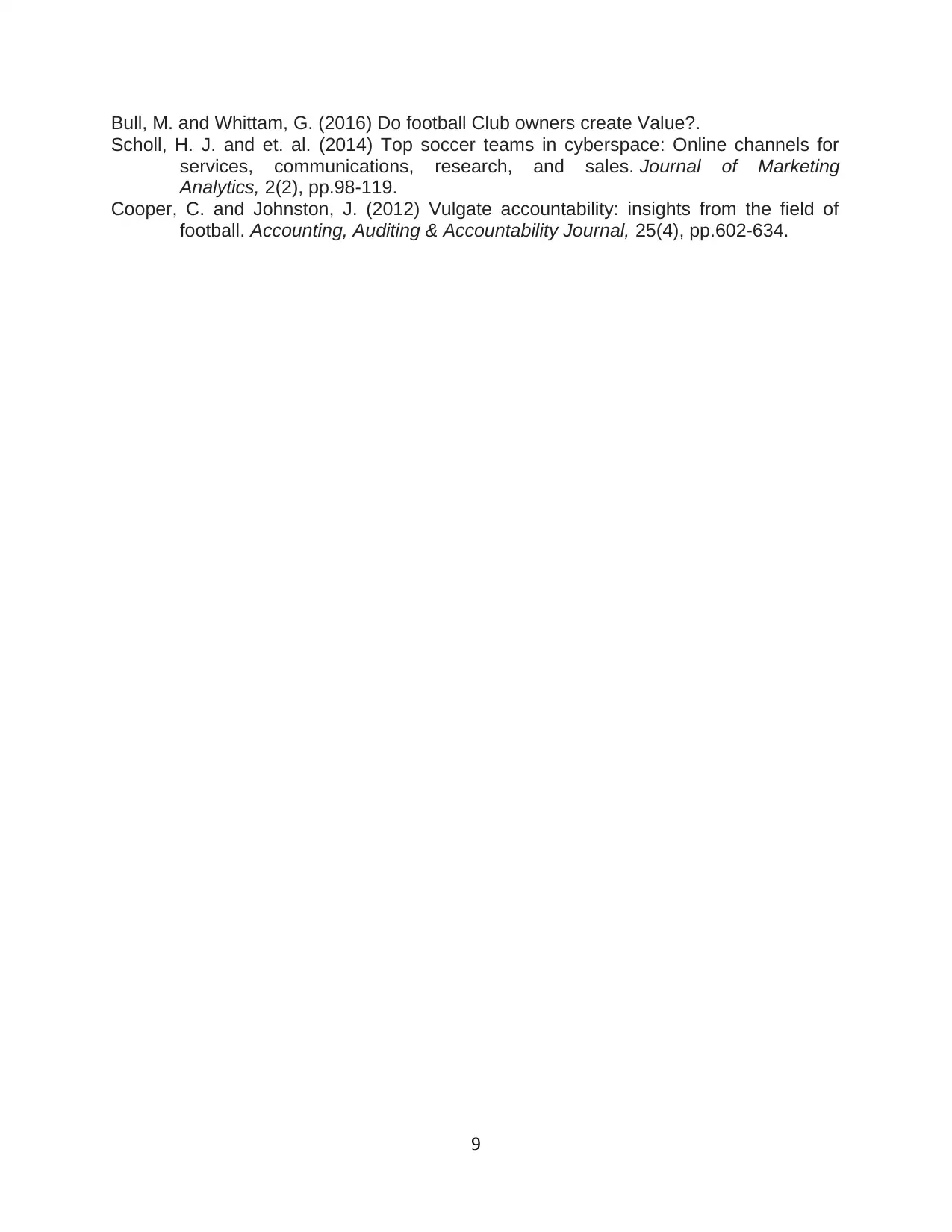
Bull, M. and Whittam, G. (2016) Do football Club owners create Value?.
Scholl, H. J. and et. al. (2014) Top soccer teams in cyberspace: Online channels for
services, communications, research, and sales. Journal of Marketing
Analytics, 2(2), pp.98-119.
Cooper, C. and Johnston, J. (2012) Vulgate accountability: insights from the field of
football. Accounting, Auditing & Accountability Journal, 25(4), pp.602-634.
9
Scholl, H. J. and et. al. (2014) Top soccer teams in cyberspace: Online channels for
services, communications, research, and sales. Journal of Marketing
Analytics, 2(2), pp.98-119.
Cooper, C. and Johnston, J. (2012) Vulgate accountability: insights from the field of
football. Accounting, Auditing & Accountability Journal, 25(4), pp.602-634.
9
1 out of 11
Related Documents
Your All-in-One AI-Powered Toolkit for Academic Success.
+13062052269
info@desklib.com
Available 24*7 on WhatsApp / Email
![[object Object]](/_next/static/media/star-bottom.7253800d.svg)
Unlock your academic potential
Copyright © 2020–2025 A2Z Services. All Rights Reserved. Developed and managed by ZUCOL.





